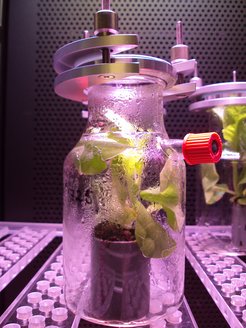At the methane source of plants
Plants produce greenhouse gas from the amino acid methionine
There are more natural sources of the greenhouse gas methane than previously known to science. Plants are one of these sources. A German-British team led by researchers of the Max Planck Institute for Chemistry in Mainz and the University of Heidelberg, recently discovered that methane in plants is produced from the amino acid methionine, which all living organisms need for the building of proteins. The scientists also propose a mechanism which could explain the abiotic production of methane, i.e. without the aid of enzymes, in plant cells. Already in 2006, the Max Planck researchers discovered that plants can release the gas. However, it remained unclear how the hydrocarbons were created in the plants. Researchers have now discovered that methane is also released from fungi. Until a few years ago, it was only known that the gas is formed naturally in volcano eruptions, forest fires and by microorganisms which metabolize without oxygen.

The traces of methane in the atmosphere are small but they have a great impact on climate. After all, its greenhouse effect is 25 times greater than that of carbon dioxide. This means that when Frank Keppler, together with his working group from the Max Planck Institute for Chemistry and the Ruprecht-Karls University of Heidelberg discovered new sources of methane, it is also relevant to the understanding of the climate. If nothing else, the researchers broke down the biology dogma, when a few years ago, they discovered that methane is not only produced by microorganisms but also, especially now, by oxygen.
As happens most of the time when a researcher challenges a doctrine that has been accepted for decades, some experts have difficulties in accepting the new point of view. The Mainz researchers, however, can now refute one argument of the sceptics. They have not only identified the sulphur containing amino acid methionine as a substance that emits the environment damaging gas, but also provide indications about how this could be happening. “Some critics held it against us that we could not explain this previously,” says Frank Keppler.
Labelled methionine reveals the plant methane source
In order to get to the bottom of the methane source, Keppler and his colleagues took two approaches. Firstly, they infiltrated tobacco plant leafs with specially labelled methionine and let the offshoots grow on a culture medium with the prepared methionine in further experiments. The amino acid in the methyl group which scientist considered could be a precursor for methane, received a particularly high amount of carbon-13. This heavy carbon isotope can be clearly differentiated from ordinary carbon-12 in appropriate analyses. “We then found the labelled carbon atom in the methane which was emitted from the plants,” says Frank Keppler.
Secondly, the researchers conducted test-tube experiments, in an aqueous solution - a realistic scenario, as most plant cells largely consist of water. They combined various methylated substances, which contain a methyl group derived from methane such as for example methionine, dimethyl sulphoxide or lecithin with iron ions, ascorbic acid and hydrogen peroxide. The latter are also responsible for the incorporation or removal of methyl groups in other molecules in plants, fungi and animals. In the experiments methane was formed from methionine and a few other sulphur containing substances which, however, are not found in plants - this happened by abiotic means, i.e. without any biochemical addition of enzymes.

“Apparently the linking of the methyl group with another sulphur atom is a prerequisite for this,” says Frank Keppler. “Methane was only produced in noteworthy quantities in such substances.” The hydrocarbon was also split off in the form of dimethyl sulphoxide. “In plants this does not play a role, however in algae this could be an important chemical precursor from which methane is emitted,” says Keppler. “This finding could be of great assistance in explaining the methane-ocean paradox.” A considerable amount of methane is emitted from the world’s oceans, although the oceans have a high oxygen content. Biologists cannot explain this as long as they accept the assumption that microorganisms only produce methane when no oxygen is available.
Methane, a coincidence or waste product?
“We have not proven yet if the abiotic mechanism which we observed in the test-tubes also really works like this in plants,” says Frank Keppler. “This is what we want to find out in future work.” By identifying methionine as the chemical precursor for greenhouse gas, they already took the first step. At the moment it is also still unclear if methane forms in plants by coincidence, as a result of the required substances coming together in their cells at this particular point in time. Or whether it is a waste product, so to say, from a reaction of which the other products are important for the metabolism of plants.
However, it is already evident that plants contain other, previously unknown sources of greenhouse gases, in addition to methionine. For example, in fungi, methane also forms from methionine. This was recently proven by researchers led by Frank Keppler. In addition, the gas is also produced in plants in other ways. In earlier works, researchers observed that UV light releases methane from plant pectin. This photochemical mechanism plays an important role in the decomposition of dead plant material, while the process observed now, occurs in living plants.
It is not yet possible to assess the quantities of methane emitted from the sources that Frank Keppler and his colleagues have found in plants, fungi and possibly also animals. Consequently, it is also not yet clear what role these methane emissions play with regard to the climate. Researchers will only be able to present reliable prognoses about this once they have found and understood all previously unknown methane sources, when they know which factors, as for example UV radiation or oxygen content in the environment, impacts on the emission of methane. This is exactly what the researchers led by Frank Keppler are working on.
SB/PH













